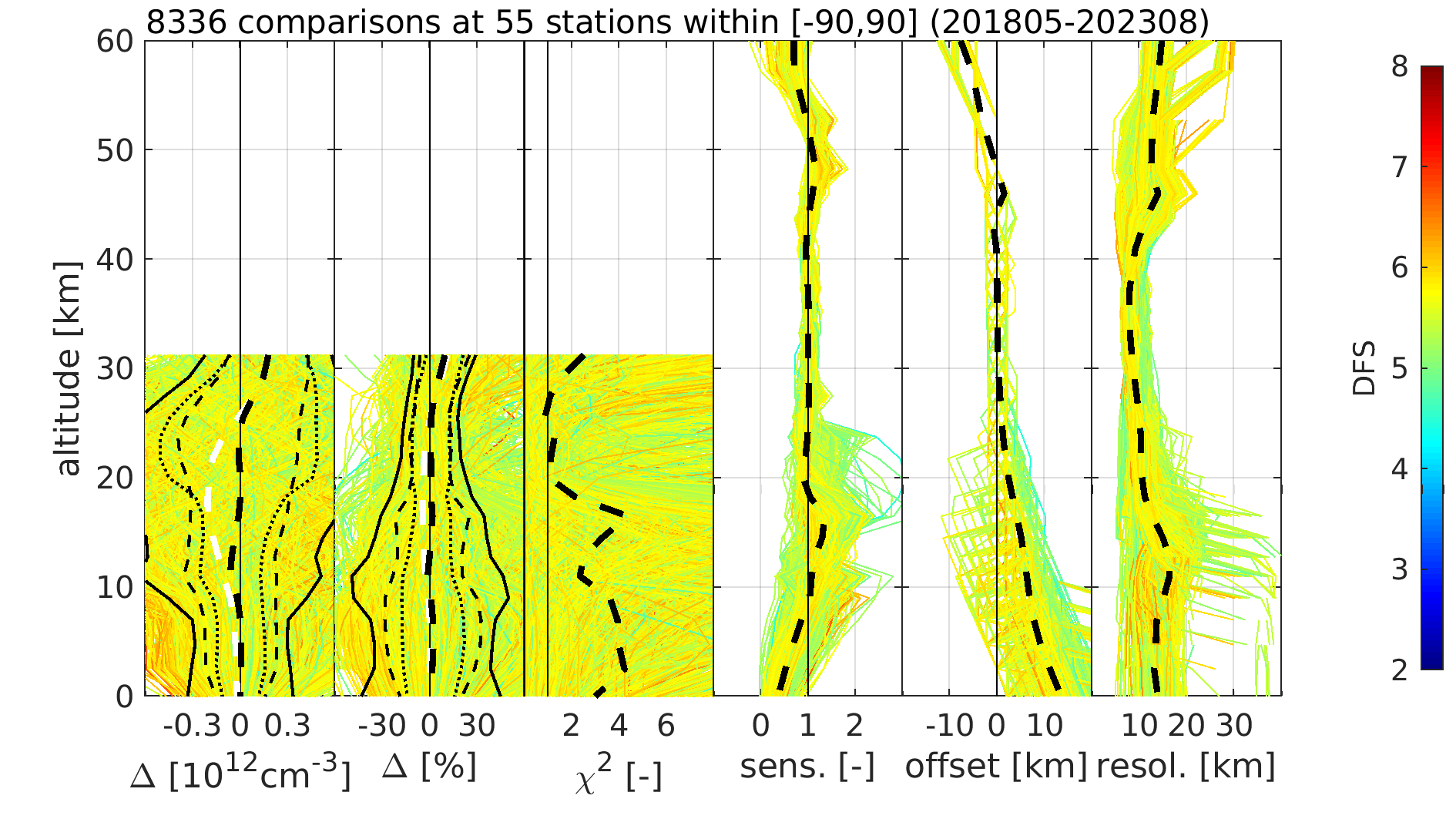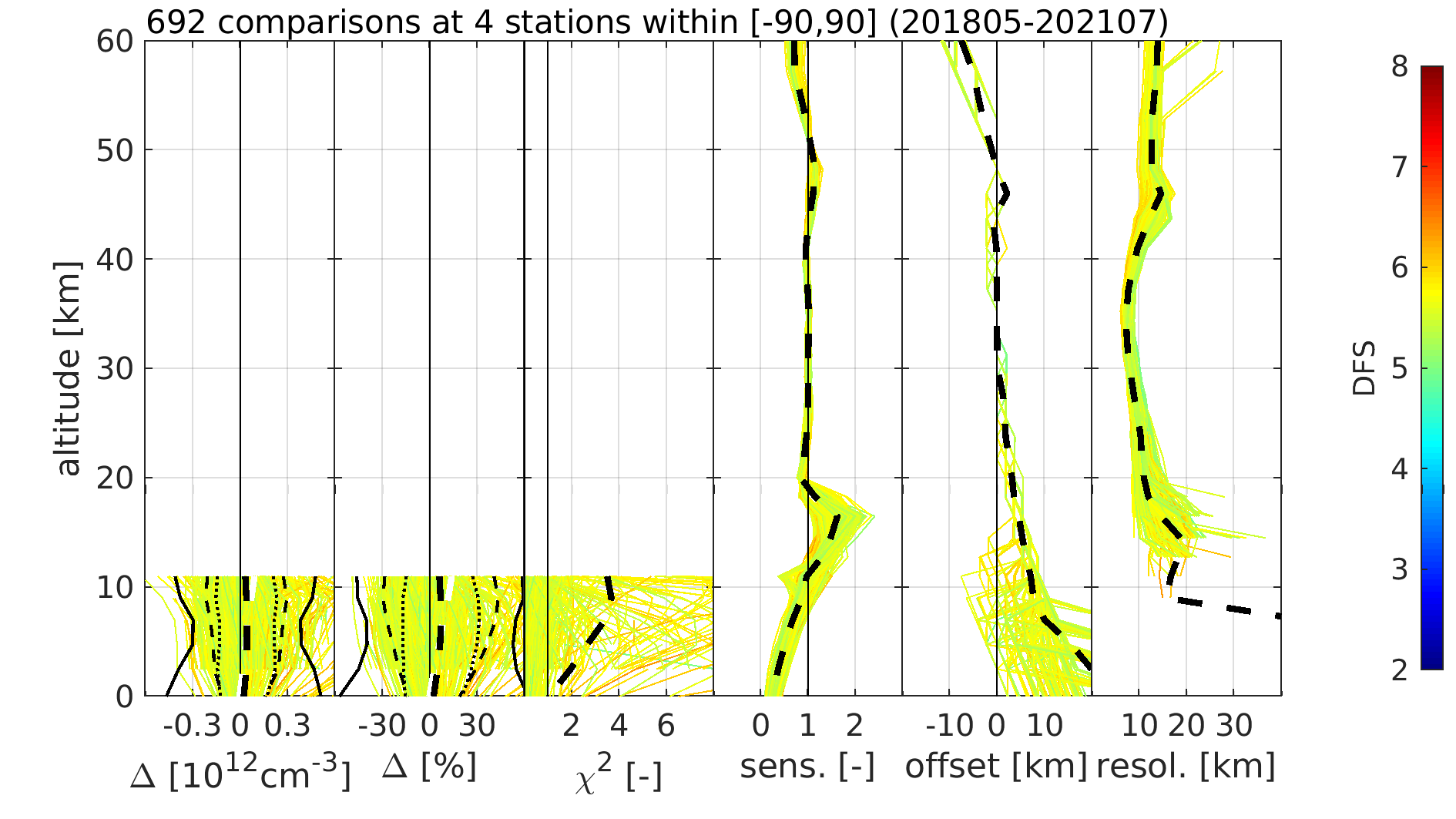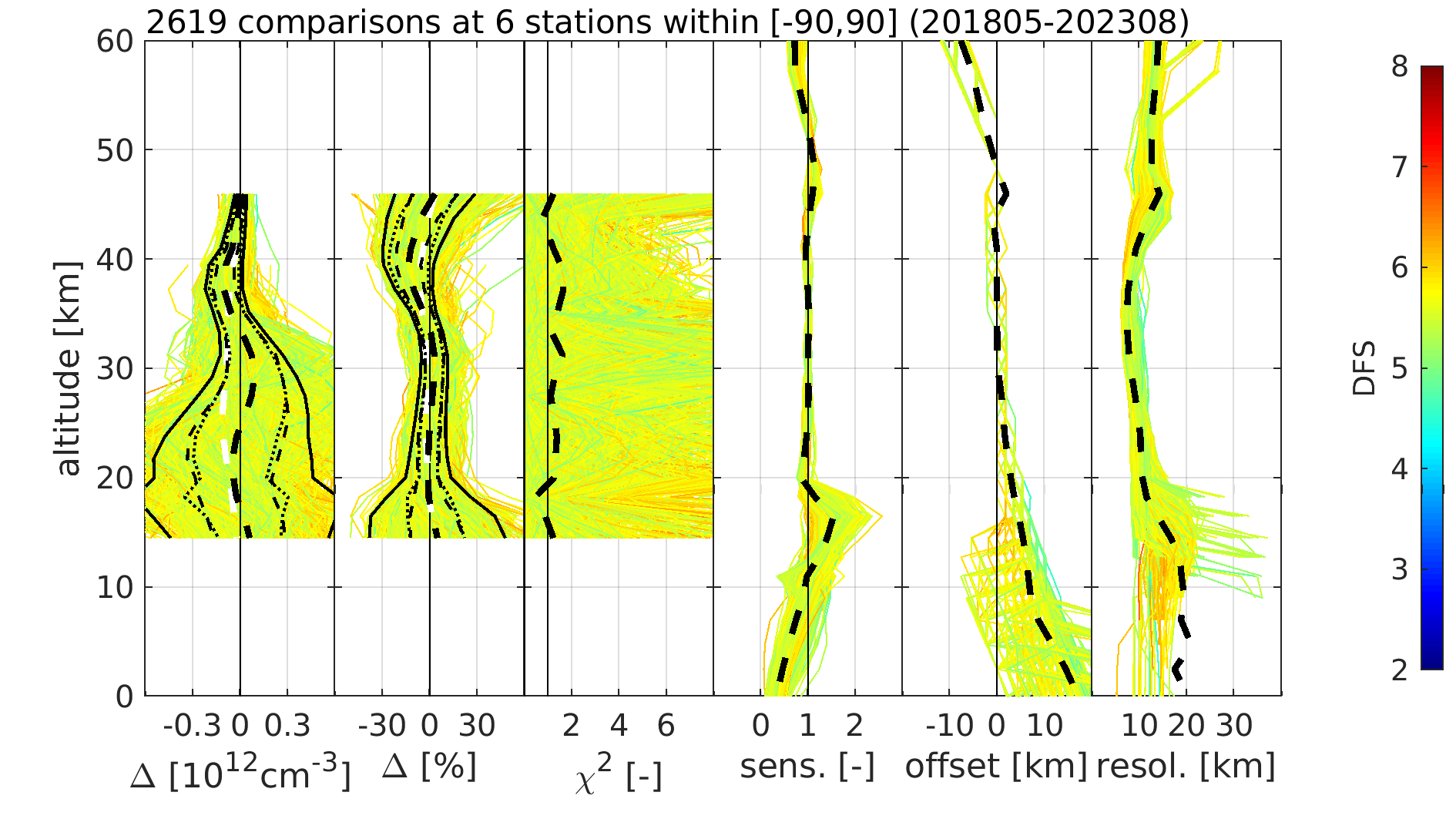Validation Summary
Sentinel-5p TROPOMI provides one operational ozone profile data product: L2_O3_PR Ozone Profile
Accurate retrieval of nadir ozone profile data requires the recalibrated TROPOMI Level-1b data (v2). Operational TROPOMI ozone profile data (v2.3) based on L1b v2.0 have become publicly available since November 29, 2021. A switch to L2 processor version 2.4 has been made in July 2022, followed by a reprocessing of the entire dataset based on L1b v2.1 with improved soft-calibration. Routine validation results for the NRTI and RPRO/OFFL ozone profile streams are provided here.
Comparison of the Sentinel-5p TROPOMI L2_O3_PR data (May 2018 to November 2023 for both NRTI and RPRO/OFFL channels of the operational NL-L2 processors) with ozonesonde and lidar measurements concludes to a median agreement better than 5 to 10 % in the troposphere and up to the upper troposphere/lower stratosphere (UTLS). The bias goes up to -15 % in the higher stratosphere (35-45 km), but with vertical oscillations. The comparisons show a dispersion of order of 30 % in the troposphere, and 10 to 20 % in the UTLS and upper stratosphere. Chi-square tests demonstrate that on average the observed differences confirm the ex-ante satellite and ground uncertainty estimates in the stratosphere, above about 20 km. Around the tropopause and below (around 15-20 km and lower), the mean chi-square value increases up to about four. Here, the retrieved satellite uncertainty is smaller than what is actually observed.
The information content of the ozone profile retrieval is characterised by about five to six vertical sub-columns of independent information (estimated from the Degrees of Freedom) and a vertical sensitivity nearly equal to unity at altitudes from about 20 km (UTLS) to 50 km, and decreasing rapidly at altitudes above and below. The altitude registration of the retrieved profile information usually is close to the nominal retrieval altitude in the 20-50 km altitude range, and shows positive and negative offsets of up to 10 km below and above the 20-50 km altitude range, respectively. The effective vertical resolution of the profile retrieval usually ranges within 10-15 km, with a minimum close to 7 km in the middle stratosphere. Increased sensitivities and higher effective vertical resolutions can be observed for higher solar zenith angles, as can be expected, and correlates with higher retrieved ozone concentrations. On the other hand, one can also observe some lower-DFS profiles with nearly-zero surface sensitivity in combination with a highly overcompensating sensitivity around the UTLS, ranging up to three and above. These retrievals occur for scenes that have both high SZA and high surface albedo, mostly around the Antarctic (latitudes from 60 to 90 south).
A solar-zenith angle dependence is observed for the lowest ozone subcolumns, which translates into a seasonal and meridian dependence of their bias. Whereas there is an increase of the DFS and bias for the 6-12 km column with SZA, this correlation seems to be somewhat compensated for the lowest column by increased atmospheric penetration of the sunlight at low solar-zenith angles (0 to about 30°). A similar but reduced effect can be seen for the viewing-zenith angle. Additionally, the bias is clearly negatively correlated with the surface albedo for the 6-12 km subcolumn, despite the latter’s apparently slightly positive correlation with the retrieval DFS.
The more than five years of TROPOMI ozone profile data show a slight DFS degradation throughout the mission (next to a jump from the ground pixel resolution change). Comparisons with ozonesonde data reveal significant positive drifts near 2 %/year in the tropics and mid-latitudes from the surface to the UTLS, while 1-2 % per year negative drifts are observed above. This makes the current operational TROPOMI ozone profile product and its subcolumn derivatives unsuitable for vertically resolved trend studies. However, no significant drift is detected for the vertically integrated profile. This agrees with the operational TROPOMI total ozone column retrieval.
Global maps of the six ozone profile sub-columns show the geographical coverage of the data, but also a slight along-orbit striping, especially in the middle stratosphere (24-32 km sub-column). Global maps of the integrated L2_O3_PR ozone profile data and of the L2_O3 total column data look mutually consistent, although the latter is about 5 % higher than the integrated ozone profile on average. On the other hand, orbit curtain plots reveal that for some ground pixels the retrieved ozone profile deviates strongly and non-physically from the a-priori profile used in the retrieval. This issue needs further examination. Finally, in the absence of clouds, data files sometimes contain negative surface albedo values. The ground pixels affected by this anomaly are usually located at the east and west edges of the TROPOMI measurement swath.
| Product ID | Stream | Version | Orbits | Bias (req. 30 %) | Disp. (req. 10 %) | Special features |
|---|---|---|---|---|---|---|
| L2_O3_PR | NRTI | 02.04.00 02.05.00 |
24697-28074 28078-now |
5-10 % | 10-30 % | Mean agreement better than 5 to 10 % in the troposphere and UTLS. Bias goes up to -15 % in the higher stratosphere (35-45 km), but with vertical oscillations. Dispersion of order of 30 % in the troposphere, and 10 to 20 % in the UTLS and upper stratosphere. |
| OFFL | 02.04.00 02.05.00 |
24655-28030 28031-now |
5-10 % | 10-30 % | ||
| RPRO | 02.04.00 | 2818-24779 | 5-10 % | 10-30 % |
The graphs below show the comparison between S5P L2_O3_PR OFFL ozone number density profile data and all co-located ground-based reference measurements (May 2018 to November 2023, top: ozonesondes, middle: tropospheric lidar, bottom: stratospheric lidar). From left to right: the difference and the percent relative difference between S5P and ozonesonde data, the chi-square profile, the vertical sensitivity, the altitude registration offset, and the averaging kernel FWHM associated with the S5P retrieval. The colour scale indicates retrieval degrees of freedom. Black dashed lines show mean values (thick lines) and standard deviations (thin lines, around the mean), while white dashed lines indicate the mean difference between the a-priori profile and the reference measurement. Dotted black lines indicate the total ex-ante (inductive) uncertainty of TROPOMI and the reference measurements combined (around the mean difference).
A detailed description of the method and a comprehensive discussion of validation results can be found in the Quarterly Validation Report #21: April 2018 - November 2023.


